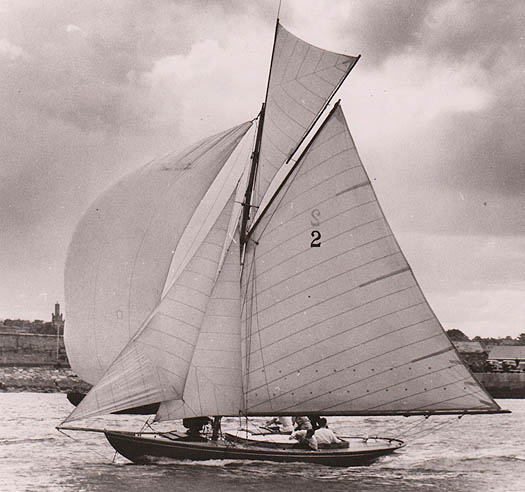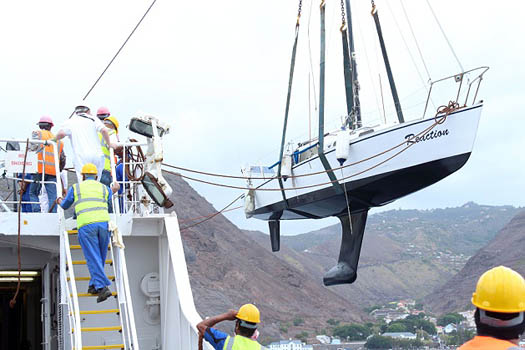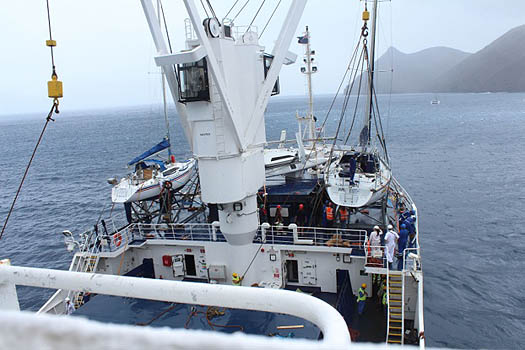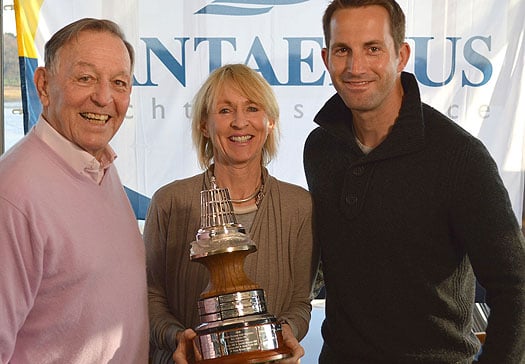#oldgaffers – There's a painful irony in the Old Gaffers Association choosing Dublin Bay as one of the focal points for their season-long Golden Jubilee celebration this summer. In 1963, the OGA came into being "to preserve interest in, and encourage development of Gaff Rig, and to participate in the maintenance of our Maritime Heritage". But that same year, the owners of the seven Dublin Bay 21ft One Designs persuaded veteran yacht designer John B Kearney to convert their beautiful Alfred Mylne-designed 1903 gaff cutters to Bermudan rig.
Today's sailors may wonder why old salts get so emotional about the Dublin Bay 21s. The past is a different and distant country, a long way away, and the heyday of the Dublin Bay 21s was aeons ago. But please believe that in their prime, the Dublin Bay 21s were just about the most perfect, the most beautiful, the most gallant small gaff cutters ever created. With their spectacular jackyard tops'ls, they were demanding creatures. They were thoroughbreds, a joy to sail, and the providers of tremendous sport.

The crème de la crème. In their prime, the Dublin Bay 21s were the most beautiful small gaff cutters in the world
Yet in 1963, with sailing being taken over by plastic boats and modern rigs, the DBSC 21ft owners felt they'd no choice if they were to attract newcomers as crews and owners. And for some decades, the boats with their masthead Bermudan rigs continued as a viable class. Today, however, the seven mouldering hulls are entombed in a Wicklow farmyard. And when the Old Gaffers Association make a four day visit to Dublin from May 31st to June 3rd, tangible reminders of the glory days of gaff rig racing in Dublin Bay will actually come from outside the bay, with the Howth 17s racing round the Baily to join the festivities which will be focused on Poolbeg Y & BC in the mouth of the River Liffey, where most of the members of the Dublin Bay Old Gaffers Association are based.

Thriving survivors of a golden age of gaff rig racing. The Howth 17s Aura (1898) and Pauline (1900) in the annual race round Lambay. The race round the North Dublin island was first sailed in 1904. Photo: John Deane
Despite its seemingly uncompromising name, the Old Gaffers Association is a rather amorphous body. Doubtless there was a time when an Orwellian attitude of "four sides good, three sides bad" prevailed with regard to the shape of your mainsail. But there are now so many vintage boats which were Bermudan rigged at birth that they are also happily involved and accepted.
It seems you only have to think that your boat is either traditional or a classic, and you're in. So with my reasonably mature Bermuda-rigged little American glassfibre sloop, I too have joined the Picklefork Club. The what? The Picklefork Club. It's simple, really. The symbol of the old gaffers on their burgee is the profile of gaff jaws, which you'd think is unmistakable. But while cruising in the English Channel some years ago with old gaffers all about and flying the flag, my determinedly ignorant shipmates decided this could only represent something called the Picklefork Club. So for the remainder of the cruise (which involved going to St Malo to see a boat built by James Kelly of Portrush in 1897, but that's a story for another time) it became the Picklefork Club, and has remained so ever since.
Yet although the Old Gaffers have been around for 50 years, and the Howth 17s for 115, they've never officially got together, so the Poolbeg assembly will be a breaking of new ground. It promises to be a fascinating gathering, as the theme of the Golden Jubilee is a rolling clockwise circuit cruise of Great Britain, with boats joining and leaving as they wish, its route veering sufficiently west to take in Dublin Bay and Belfast Lough.
Some boats will go the whole way, on through the Caledonian Canal and down the east coast of Scotland and England. It is expected this voyaging group will include boats from the strong Dutch and French memberships, which will bring craft like a giant Galway hooker built in steel from the Netherlands. As local boats from all corners of the Irish Sea are also expected, it will be one very eclectic fleet, and then some. Variety being of the essence for this main fleet, the arrival of a one design class of classically gaff-rigged boats of unimpeachable vintage will enliven things on the Saturday afternoon (June 1st) as the Seventeens race in from Howth.
A love of old boats and a sense of community is the cement that holds the Seventeens together, but it is the bracing effect of racing which energises the class. Since May 4th 1898, the weekly Saturday afternoon race at Howth has been the backbone of the class's busy annual programme. It's almost set in stone, but fortunately there were enough like-minded people in Howth who thought the OGA Golden Jubilee was a Good Thing, Worthy of Support, in order to float the idea.
So not only are the Seventeens going to race to Poolbeg (and on a Bank Holiday Saturday too), but for good measure on the Sunday they'll be racing between the bridges on the Liffey. As for the bigger boats in the main fleet who wish to race, on the Saturday there's a race for the RMS Leinster Trophy (named for the mailboat torpedoed in 1918) from Dun Laoghaire round the available islands and buoys to Poolbeg, and then on the Sunday they race in Dublin Bay for the new Asgard trophy, made up from spare timber saved by John Kearon, conservator of Erskine Childers' Asgard.
In all, it's a user-friendly programme which shouldn't be too demanding for even the oldest Old Gaffer. And as it's all about shared enthusiasm, we can be sure that the hard core of devotees will enjoy themselves whatever the weather. But for the rest of us, let's hope the jetstream is sufficiently distant to ensure that the first weekend of June 2013 bring glorious summer to Dublin Bay.
ANOTHER GONG FOR BEN
Today's choreographed awards ceremonies, with the buildup of what is often pseudo tension as the short list is recited, are something many of us would happily avoid in any capacity. So it was a breath of fresh air earlier this week when news of the annual YJA Pantaenius Yachtsman of the Year awards across the water came in, complete with photos of the trophy going to Ben Ainslie.
Recently made Sir Ben, he's a busy boy. In post-Olympic mode, he's up to his tonsils with an America's Cup campaign, and was booked to be on his way back to San Francisco when the trophy was due to be formally handed over in London.
But Ben is based in Lymington, as too is YJA Chairman Bob Fisher, while Lady Pippa Blake, who was to perform the ceremonial in London, lives further east along the Solent at Emsworth. So what could be easier than they all get together of a January morning at the Royal Lymington, and get the photos of the handover just before Ben takes off for the US of A.
An awards ceremony for our times – Bob Fisher, Pippa Blake and Ben Ainslie in Lymington with the YJA Pantaenius Yachtsman of the Year 2012 trophy. Photo: PPL
Awards ceremonies should always be like this – dontcha just love the Fish's matching shirt and pullover in a class of pale lilac? Nevertheless, we appreciate that some folk might think this is all just a little bit too casual, so we'd better give it a Court Circular makeover:
Lymington, Monday
Sir Benjamin Ainslie, Keeper of the Four Gold Medals, was this morning received by Lord Fish of Brittlesea in the Royal Lymington Yacht Club, with Lady Pippa Blake in attendance. After the usual exchange of pleasantries about the weather and the minor problems encountered in the Southampton traffic when journeying from West Sussex, Lady Blake then presented Sir Benjamin with the YJA Pantaenius Yachtsman of the Year Trophy for 2012, which Sir Benjamin was pleased to accept.
Following some discussion as to whether the photographs would be better taken in the clubhouse or on the balcony, both settings were used. Lady Blake was then thanked by Lord Fish of Brittlesea, and conferred with the title of Designated Driver, as the catering facilities in the Royal Lymington Yacht Club were closed, it being Winter Hours.
Lady Blake then conveyed the party to the Chequers public house for a bar luncheon, where they savoured the vegetarian option, the battered cod with hand cut chips, and the succulent beefburger. Sir Benjamin enjoyed his last pint of Badger Beer for some time as they don't have stuff like this in Frisco, and then went home to complete his packing and leave for America.
SAILING'S SKI LIFT
Even in a mighty maxi, windward work in the open sea in a real breeze is rugged going. On one such occasion, as we wondered at the bashing the big boat was taking while reflecting that even with it, the speed was still nothing great, a veteran of many big boat races on the rail beside me gave the received and terse opinion:
"Nothing goes to windward like a 747".
All too often, the joy of a downwind skite is diminished by the thought of having to slug back up again. Why can't sailing have the equivalent of a ski lift? Well, if you sail out of Cape Town, it does.
The bi-annual Governor's Cup race over Christmas and January from the Cape's historic navy port of Simon's Town to St Helena is 1,700 miles of fast sleighride in the barreling southeasterly trade winds. Despite being up against 19 other boats, some of them seriously big ones, the winner was the relatively small sloop Reaction. Owned by Thinus Grinwald, she's one of those slippy little van der Stadt designed Royal Cape ODs, boats with a distant relationship to Black Soo, another van de Stadt offwind flyer which was long based in Ireland.

Governor's Cup winner Reaction is lifted aboard the Royal Mail vessel at St Helena for the return to Cape Town
Black Soo was phenomenal offwind in a big breeze, but she was very tough going to windward in a blow. Doubtless it's the same with Reaction. But they didn't have to test it, as they'd booked to have her shipped back with seven of the other smaller boats from St Helena to Cape Town on the Royal Mail vessel which serves that very remote South Atlantic island.
On this sailing ski lift, it took them five very pleasant days to get back to the Cape, and even with all the partying on St Helena, there was more conviviality on the ski-lift cruise home. With just four on board, Reaction had gone to St Helena in 11 days and 23 hours. It boggles the mind to think how long they'd have taken to sail back.

Any more for the Skylark? Eight boats secured themselves a sailing ski-lift uphill against the southeast trades, 1700 miles back home from St Helena to Cape Town

































































